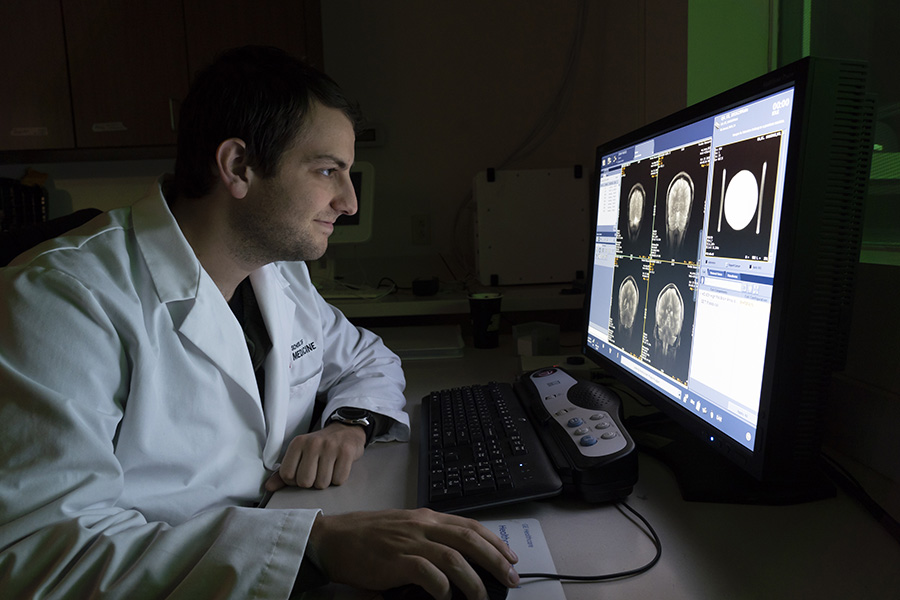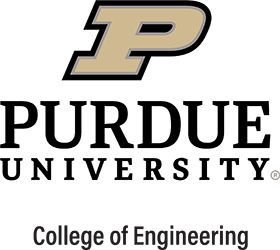MD/PhD Candidate Sees More to Learn from Imaging
One of a physician's worst nightmares is a cancer that is "on the move." These malignancies require the best possible technology to detect ominous hotspots that may emerge anywhere throughout a patient’s body. An MD/PhD student in the Indiana University Medical Scientist Training Program (MSTP) has received broad support for research to track even the smallest metastatic cancers so that patient-centered therapies can be designed with accuracy and confidence.

This effort has been undertaken by Nate Smith, awarded a Leslie Bottorff Fellowship during his first year of research in his doctoral program jointly sponsored by Purdue University's College of Engineering and Indiana University School of Medicine. Shortly after completing his first two years as a medical student, Smith joined with an interdisciplinary cadre of advisors and researchers to develop an imaging procedure using positron emission tomography (PET) and a new radioactive copper tracer to find areas where cancer may be hiding.
Cancers like to make their own blood vessels and hog blood supply, so abnormal blood flow and tissue perfusion can act as markers of cancer metastasis. Moreover, the radiocopper tracer molecules can be imaged quickly enough by a PET-scan device to capture the whole-body context, whereas other perfusion monitoring can only scan limited regions of the body.
Smith says that this method of imaging can lead directly to improved diagnoses and treatment, which fits his long-standing passion to translate research discoveries for medical use. The relatively rare receipt of the Bottorff fellowship during the first year of his MD/PhD research partly reflects Smith’s passion for technological innovation, grounded in a commitment to translational research he has felt since deciding to go to medical school.
While earning a bachelor’s degree in physics and math, already drawn to research and imaging technologies, he pursued connections to the medical world. He assisted at the Indiana University George M. O’Brien Center for Advanced Microscopic Analysis, where a team of scientists and engineers performs digital image analysis of the human kidney. Smith also shadowed practitioners in the Radiology department of a regional hospital. Soon, he decided to focus his junior and senior years on preparing for a career in medicine. His interest in imaging remained intact, and his hospital observation time taught him cutting-edge technological advances need to reach practitioners around the country more quickly.
"It opened my eyes to the world of possibilities that research could reveal, benefiting what we were able to do in the radiology clinic," Smith says. His goal of combining lab work with a medical career through translatable progress in technology was set, and his college coursework had given him a foundational background that he could apply to his new research in engineering.
He knew he faced a steep "learning curve," but he applied to MD/PhD programs for aspiring engineers anyway. When accepted into the Purdue University-Indiana University partnership, he seized the opportunity to pursue "two top-ranked degrees simultaneously." The interdisciplinary group assembled to guide the four-year Ph.D. portion of his studies is well-suited to develop his engineering expertise while also fostering his skills as a researcher and medical practitioner.
That team reflects the wide-ranging collaborations across multiple disciplines that are required to support his PET perfusion research. His co-advisors are Craig Goergen, Ph.D., and Gary Hutchins, Ph.D., both of whom direct labs as faculty members in the Weldon School and IU School of Medicine, respectively. Goergen leads the Cardiovascular Imaging Research Laboratory (CVIRL), while Hutchins’ lab concentrates on clinical imaging in nuclear medicine.
Because Smith's research is focused on radiocopper tracers in the context of particular cancers, he asked mentors from the IU School of Medicine to also join his oversight team. They include Tom Gardner, MD, a urologist, and Justin Sims, MD, a radiologist specializing in nuclear medicine.
The Bottorff Fellowship support will extend Smith's interdisciplinary energies by funding travels back and forth between research and clinical resources in Indiana, plus far more expensive travels to major national conferences.
After completing medical school in 2025, Smith anticipates combining research, clinical practice, and teaching in his career. "You have to be a hybrid animal to truly make the difference that needs to be made," he says, reflecting on his previous hospital experiences. His research will have a heightened sense of interdisciplinarity, and his efforts in academia will advance future capabilities to meet patients' needs.
Meanwhile, on the Indianapolis and West Lafayette campuses, Smith helps to promote the needs of his fellow MD/PhD students, serving on their own student councils to make programmatic proposals to administrators.
One can also find Smith investing his energy for wellness and recreation. He plays pickup games of Ultimate Frisbee and soccer. At any given time, he says, he may be lifting weights or competing in his family’s weekly trivia games, playing the piano or singing in his church’s choir, or perhaps doing a 5K run.
His commitment to years of MD/PhD studies may seem laborious, but he takes a broader view. His education has many moving parts, connecting diverse pursuits to a unified sense of purpose. His course of study is unique, and as Smith puts it: "I think I ended up in the best possible program for me."


